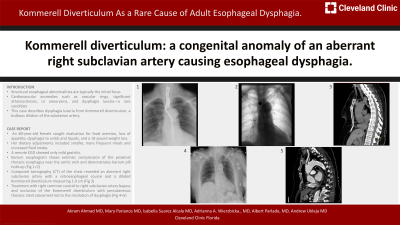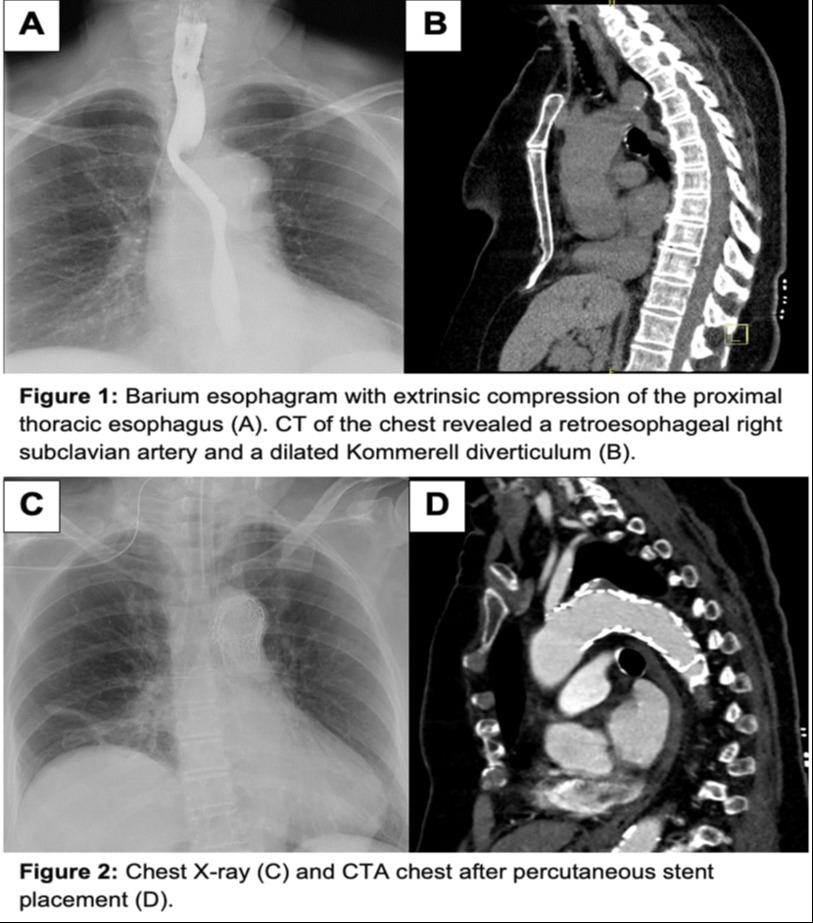Tuesday Poster Session
Category: Esophagus
P4014 - Kommerell Diverticulum as a Rare Cause of Adult Esophageal Dysphagia
Tuesday, October 29, 2024
10:30 AM - 4:00 PM ET
Location: Exhibit Hall E

Has Audio
- AA
Akram Ahmad, MD
Cleveland Clinic Florida
Weston, FL
Presenting Author(s)
Award: Presidential Poster Award
Akram Ahmad, MD1, Mary Parianos, MD2, Isabella Suarez Alcala, MD3, Adrianna Wierzbicka, MD1, Zaid Ansari, MD4, Albert Parlade, MD1, Cedric Sheffield, MD1, Andrew Ukleja, MD1
1Cleveland Clinic Florida, Weston, FL; 2Holy Cross Hospital, Fort Lauderdale, FL; 3Palmetto General Hospital, Hialeah, FL; 4Cleveland Clinic Florida, Plantation, FL
Introduction: Structural esophageal abnormalities are typically the initial focus in evaluating esophageal dysphagia. Infrequent etiologies include cardiovascular anomalies, vascular rings, significant atherosclerosis or aneurysm, and a congenital anomaly of the right subclavian artery causing esophageal compression. This report describes a rare case of dysphagia lusoria from Kommerell diverticulum, a bulbous dilation of the subclavian artery.
Case Description/Methods: An 80-year-old female with a past medical history of mild gastroparesis and hypertension sought evaluation for food aversion, dysphagia to solids and liquids, and 10-pound weight loss. She denied other gastrointestinal symptoms. Her dietary adjustments included smaller, more frequent meals and increased fluid intake. A remote esophagoduodenoscopy six years ago showed only mild gastritis. The barium esophagogram revealed an extrinsic compression of the proximal thoracic esophagus near the aortic arch and held off the barium pill. Subsequent computed tomography (CT) of the chest without contrast revealed an aberrant right subclavian artery with a retro-esophageal course and diverticulum of Kommerell of 1.9 cm. A CT angiography of the chest identified a left-sided aortic arch with aberrant origin of the right subclavian artery, dilated 1.7 cm behind the esophagus, prompting referral for surgical intervention. The patient underwent surgery, right thoracotomy with resection of the vascular ring, right carotid subclavian bypass, and percutaneous thoracic stent placement using endograft. The patient’s symptoms of dysphagia resolved after surgery.
Discussion: Kommerell diverticulum is a rare cause of esophageal dysphagia, resulting from a congenital anomaly with an aberrant course of the right subclavian artery and the development of an aneurysm at its origin. Symptoms can arise from the compression of the trachea or esophagus depending on the aneurysm's size or anatomical path. Our patient's progressive symptoms were due to posterior extrinsic compression by the Kommerell diverticulum. Surgery was necessary to correct the underlying condition. While surgical repair often involves resection of the aneurysm and revascularization, including bypass grafting, it carries significant risks. Therefore, establishing standardized guidelines for surgical intervention and assessing the risks versus benefits of observation are crucial. Surgery was highly successful in this case.

Disclosures:
Akram Ahmad, MD1, Mary Parianos, MD2, Isabella Suarez Alcala, MD3, Adrianna Wierzbicka, MD1, Zaid Ansari, MD4, Albert Parlade, MD1, Cedric Sheffield, MD1, Andrew Ukleja, MD1. P4014 - Kommerell Diverticulum as a Rare Cause of Adult Esophageal Dysphagia, ACG 2024 Annual Scientific Meeting Abstracts. Philadelphia, PA: American College of Gastroenterology.
Akram Ahmad, MD1, Mary Parianos, MD2, Isabella Suarez Alcala, MD3, Adrianna Wierzbicka, MD1, Zaid Ansari, MD4, Albert Parlade, MD1, Cedric Sheffield, MD1, Andrew Ukleja, MD1
1Cleveland Clinic Florida, Weston, FL; 2Holy Cross Hospital, Fort Lauderdale, FL; 3Palmetto General Hospital, Hialeah, FL; 4Cleveland Clinic Florida, Plantation, FL
Introduction: Structural esophageal abnormalities are typically the initial focus in evaluating esophageal dysphagia. Infrequent etiologies include cardiovascular anomalies, vascular rings, significant atherosclerosis or aneurysm, and a congenital anomaly of the right subclavian artery causing esophageal compression. This report describes a rare case of dysphagia lusoria from Kommerell diverticulum, a bulbous dilation of the subclavian artery.
Case Description/Methods: An 80-year-old female with a past medical history of mild gastroparesis and hypertension sought evaluation for food aversion, dysphagia to solids and liquids, and 10-pound weight loss. She denied other gastrointestinal symptoms. Her dietary adjustments included smaller, more frequent meals and increased fluid intake. A remote esophagoduodenoscopy six years ago showed only mild gastritis. The barium esophagogram revealed an extrinsic compression of the proximal thoracic esophagus near the aortic arch and held off the barium pill. Subsequent computed tomography (CT) of the chest without contrast revealed an aberrant right subclavian artery with a retro-esophageal course and diverticulum of Kommerell of 1.9 cm. A CT angiography of the chest identified a left-sided aortic arch with aberrant origin of the right subclavian artery, dilated 1.7 cm behind the esophagus, prompting referral for surgical intervention. The patient underwent surgery, right thoracotomy with resection of the vascular ring, right carotid subclavian bypass, and percutaneous thoracic stent placement using endograft. The patient’s symptoms of dysphagia resolved after surgery.
Discussion: Kommerell diverticulum is a rare cause of esophageal dysphagia, resulting from a congenital anomaly with an aberrant course of the right subclavian artery and the development of an aneurysm at its origin. Symptoms can arise from the compression of the trachea or esophagus depending on the aneurysm's size or anatomical path. Our patient's progressive symptoms were due to posterior extrinsic compression by the Kommerell diverticulum. Surgery was necessary to correct the underlying condition. While surgical repair often involves resection of the aneurysm and revascularization, including bypass grafting, it carries significant risks. Therefore, establishing standardized guidelines for surgical intervention and assessing the risks versus benefits of observation are crucial. Surgery was highly successful in this case.

Figure: Figure 1
Disclosures:
Akram Ahmad indicated no relevant financial relationships.
Mary Parianos indicated no relevant financial relationships.
Isabella Suarez Alcala indicated no relevant financial relationships.
Adrianna Wierzbicka indicated no relevant financial relationships.
Zaid Ansari indicated no relevant financial relationships.
Albert Parlade indicated no relevant financial relationships.
Cedric Sheffield indicated no relevant financial relationships.
Andrew Ukleja indicated no relevant financial relationships.
Akram Ahmad, MD1, Mary Parianos, MD2, Isabella Suarez Alcala, MD3, Adrianna Wierzbicka, MD1, Zaid Ansari, MD4, Albert Parlade, MD1, Cedric Sheffield, MD1, Andrew Ukleja, MD1. P4014 - Kommerell Diverticulum as a Rare Cause of Adult Esophageal Dysphagia, ACG 2024 Annual Scientific Meeting Abstracts. Philadelphia, PA: American College of Gastroenterology.

